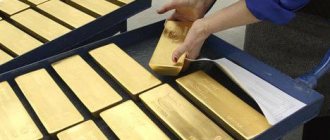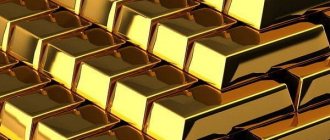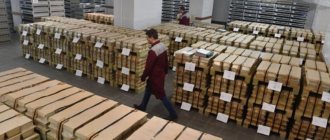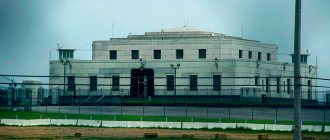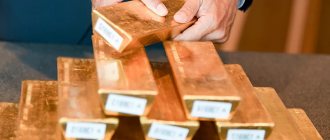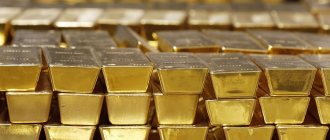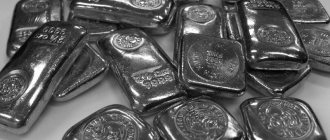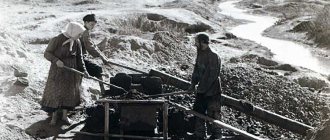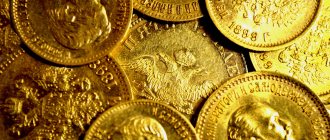The “gold fund of the nation,” which has partially survived to this day, is the gold reserve of the USSR. The amount of precious metal plays a major role in the state’s economy, opportunities and potential of the country. Often, the supply of precious metal became a cause for pride and a way to prove the power of the state; it determined and showed the extent of the extravagance of a particular ruler. The size of the reserve changed, sometimes decreasing, sometimes growing in different years of the history of our state. Since the collapse of the USSR, many have been concerned about the question of where the party’s gold went.
Gold in Tsarist Russia
One of the main factors determining stability in the country is the availability and size of the state gold reserve. By 1923, the USSR had 400 tons of state gold, and by 1928 - 150 tons. For comparison: when Nicholas II ascended the throne, the gold reserves were estimated at 800 million rubles, and by 1987 - at 1095 million. Then a monetary reform was carried out, filling the ruble with gold content.
From the beginning of the twentieth century, supplies began to deplete: Russia prepared for the Russo-Japanese War, was defeated in it, and then the revolution occurred. By 1914, gold reserves had been restored. During the First World War and after it, gold was sold (and at dumping prices), pledged to creditors, moving to their territory.
Industrialization
The current situation and the arrival of the new government have become an incentive to search for alternative ways to raise funds. Industrialization required about 4-5 billion rubles to implement its processes, while the amount of approximate profit to the treasury was 400 million.
It was decided to save the situation using any available methods. As a result, new plans and standards began to emerge that had to be implemented in the so-called five-year plans. Increased performance required an accelerated pace of work.
In 1927, Stalin personally established a five-year plan for the Soyuz-Gold trust, according to which it was now necessary to extract the required amount of the precious metal. The special task was for gold mining in the USSR to take first place in the world, ahead of even the richest mines.
However, the idea of expanding production seemed to the government insufficient to replenish the treasury, so a number of measures were taken to take away the gold in the hands of the population. Precious metal was taken through confiscation, as well as through a system of special stores where goods could be purchased and paid for in gold items. In such stores they sold simple products: flour, sugar, cereals. At the same time, the violent method of selection replenished the state treasury by only 30 tons, and trade for the precious metal - by about 220 tons.
The metal extracted in the mines amounted to 130 tons per year, but the USSR lost to South America in this matter, taking second place in the world in gold production. However, little of these funds went towards the development of the state; most of it simply ended up in the treasury’s vaults. The table on gold mining in Russia (Fig. 1) shows the leap that occurred in this industry in the 30s.
Stalin carried out a monetary reform, which helped change the monstrous exchange rate of the ruble. If you compare how much the ruble was worth against the dollar before and after the reform, you can see how the national currency rose from an absolute minimum to 2 rubles. for a dollar.
Gold cost
Until 1970, the price of gold was one of the most stable parameters in the world. The US leadership regulated the price at $35 per troy ounce. From 1935 to 1970, America's gold reserves were rapidly declining, so it was decided that the nation's currency would no longer be backed by gold. After this (that is, since 1971), the price of gold began to rise rapidly. After the price surge, the value fell slightly, reaching $330 per ounce in 1985.
The price of gold in the Land of the Soviets was not determined by the world market. How much did a gram of gold cost in the USSR? The price was approximately 50-56 rubles per gram for 583 standard metal. Pure gold was bought at a price of up to 90 rubles per gram. On the black market, a dollar could be bought for 5-6 rubles, so the cost of one gram did not exceed $1.28 until the seventies. Thus, the cost of an ounce of gold in the USSR was a little more than 36 dollars.
Loss of the USSR's gold reserves
V.B. Kuznetsov
— Associate Professor of the Department of Social Sciences and Technologies of NUST MISIS, Ph.D.
History repeats itself twice: once as a tragedy, and once as a farce. This paradox is clearly visible in the history of the loss of the USSR's gold reserves. The accumulated reserves of gold in Russia before the First World War amounted to 1.4 thousand tons [1; p.105]. The hard times of war and revolution reduced it to 150 tons. Stalin increased the gold reserves of the USSR and, despite the difficult Patriotic War of 1941–1945. and the payment of lend-lease to the USA in the amount of 1.5 thousand tons, left behind 2.05 thousand tons of gold [2; With. 450]. The Accounts Chamber of the Russian Federation, which checked the state of the country’s gold treasury in 1996, concluded: “The gold reserve of the country’s State Fund... has been exhausted” [3]. There were no severe open wars or terrible epidemics. Where did the gold go? How did the loss of the gold reserves of the Soviet power, the USSR, occur?
The reign of N.S. Khrushchev's attitude towards gold was exactly the opposite of Stalin's, who after the end of the war stopped selling the precious metal. Since 1953, over the course of 12 years, 2.9 thousand tons of gold were sold on the markets of London and Paris (according to other sources, 3 thousand tons). Most of it falls in 1963–1964, when 1244 tons were sold for grain due to crop failure [4]. In total, for the period 1953–1991. The USSR sold 8.2 thousand tons of “solar metal” on world markets [5; With. 145]. It should be borne in mind that gold was not just “eaten up”, but it was used to buy Western technologies, scarce consumer goods, secure foreign loans, and some went to the jewelry and defense industries. For example, only one modern MIG-23 fighter contains 512 g of gold, 69 g of platinum, 17.183 kg of silver [6; With. 74].
The waste of gold continued, but its production also increased due to the introduction of self-financing, maximum concentration of production and the development of new technologies. For the first time in the world, the technology of sorption leaching of gold, which was developed by Boris Nikolaevich Laskorin, was implemented for the processing of low-grade ores of the largest Muruntau deposit in Central Kyzylkum at the mining and metallurgical plant in Zarafshan. From the beginning of commissioning to the present day, this enterprise and the technology used at it have been a kind of world-class standard, and the production volume has reached 60 tons per year of bank gold bars with a purity of 99.99%. When processing gold ores using sorption technology, the associated release of such valuable metals as silver, selenium, palladium, tungsten, and rhenium was ensured. This method made it possible to radically modernize the processing of gold-containing ores, ensured the production of bank-grade gold directly at the ore processing plant, as well as the possibility of involving in the processing of ores poor in gold content, which were unprofitable using the old technology.
The absolute peak of gold production in the USSR occurred at the end of the 80s of the 20th century, when the Soviet Union reached a production level of at least 300 tons per year. In Central Asia and Armenia, before the end of the USSR, 70–75 tons of gold were mined. In total, from 1918 to 1990, 12.045 tons of precious metal were mined in the USSR [7; With. 24]. Enormous amounts of money were spent on gold mining. Nikolai Vasilyevich Melnikov, a Soviet scientist in the field of mining, academician and Hero of Socialist Labor, speaking at the Polytechnic Museum in the 70s, cited the following figures. The USSR processed 2 billion m3 of rocks per year. Half of them belonged to Glavzoloto [8; With. 577].
In the second half of the 60s, the USSR entered the international gold trading market. Historical materials categorically refute the popular opinion that “Sovzagranbanks showed very low profitability” [9; Int-t]. The USSR played “very smartly” on the world gold market by creating a special “Voschodhandelsbank” with a residence in the GDR (Berlin). In the 70s, the Soviet Union actually controlled the world gold market, although it was in second place in terms of production (200–300 tons per year) after South Africa, which produced more than 700 tons per year. The trick was that the USSR was not a member of the IMF, therefore, he could sell gold for more than $35 per troy ounce. Countries included in the IMF did not have the right to raise the price above the official one. Before perestroika, gold was extremely liquid money in the USSR for solving difficulties, incl. and food, and to improve the standard of living of the entire population.
Do not forget that the USSR was a socialist state. Yuri Yuryevich Karnaukh, director of this bank, recalled, referring to the words of the Chairman of the Board of the State Bank of the USSR V.S. Alkhimov that out of five loaves of bread in the USSR, three were paid for by Voskhod. [10; Int-t]. Skillfully playing on the gold market, the USSR sold only 200–300 tons per year, but influenced the entire world gold market, which at that time amounted to 35 thousand tons. The price of gold in the mid-80s reached $800–850/ oz., rising 23 times in 10 years. The elegance and virtuosity of Soviet operations in the gold market have been repeatedly noted by many Western business publications. For his profitable services to the Fatherland, Yu.Yu. Karnaukh was awarded the Order of the Red Banner of Labor in 1974, and in 1980 the Order of Friendship of Peoples for purchasing “at a very good price” medal gold for the 1980 Olympic Games.
According to some data, during his work in Zurich, Yu.Yu. Karnaukh and the bank he heads earned about $4 billion for the country of the Soviets [11; Int-t]. Moreover, his salary was 2 thousand Swiss francs. The Swiss cleaning lady at his bank received the same amount. In our opinion, the most fantastic method of transporting gold bars to Switzerland was chosen. “We transported it (the gold) in regular Soviet passenger planes. Seven tons of gold (in standard 12.5 kg bars) were evenly laid out under the passenger seats. For many years people flew to Zurich and did not know that they were literally sitting on gold” [12; Int-t]. Gold went to partners and buyers - the so-called. "grosbanks". Each of them had its own gold smelting and refining enterprises. Our partners erased hammers and sickles from the ingots and put their marks on them. Why? On the international market, the so-called unit is accepted as a unit. "good London bullion." It must contain between 350 and 430 troy ounces of gold (about 12.5 kg), have a metal purity of at least 995 parts per thousand, and the number and company stamp of one of the 49 gold smelters in the world. The state symbols of the USSR (the hammer and sickle) were removed because the Arab sheikhs, the main buyers of gold, were “allergic” to our symbols, as Yu.Yu explains. Karnaukh.
In the mid-80s, Voskhod Bank was hit by a series of international inspections and persecutions. Yuri Yuryevich explained the failures of the bank by the intervention of the CIA, which brought their people into the bank and “drowned” it. Albert Makeev, deputy director of the bank, sensing something was wrong, began an investigation, but was soon found dead in Zurich. “His body was returned to the USSR without many internal organs, so that the cause of death could not be established” [13; Int-t]. The Cold War continued. For the United States, the profitable and successful operation of the bank was like a bone in the throat. And if you consider that the United States put pressure on the Saudi family and dropped the price of oil, then all this worsened the economic situation and accelerated the destruction of the USSR. At the end of the 80s there was no time for trading gold.
During the years of perestroika in 1985–1987. The gold reserves of the USSR were at the level of 600–700 tons. It is necessary to point out that there are other data. But the most accurate figure is given by Nikolai Ivanovich Ryzhkov, Chairman of the Council of Ministers of the USSR, in an interview with V.I. Kalugin, editor of the magazine “Gold of Russia”. “When I headed the government (1985), the gold reserve was 500 tons. This is what was in bullion. We did not count what was in the State Repository and the Diamond Fund” [14; With. 73]. In general, the era of perestroika and especially the 90s were catastrophic for the gold industry. The export of gold abroad grew, and production fell sharply after the collapse of the USSR. Evgeniy Matveevich Bychkov, head of the USSR Gokhran in 1987–1990, provided data on the extraction of the precious metal. In 1991, 137.7 tons were mined, and in 1996 only 113.3 tons. Let us recall once again that in 1989 the USSR produced 300 tons of gold [15; With. 302].
Why has production fallen so sharply? Russia did not have its own management of the gold industry until the Goskomdragmet of the Russian Federation was created in 1993. However, the main reason was the denationalization of the gold industry. Privatization of the gold mining industry proceeded rapidly. Instead of 12 powerful associations of the USSR period, by 1993 more than 700 were already functioning. Gold production in some companies barely reached 20 kg per year. In the Krasnoyarsk Territory, before privatization, a gold mining enterprise produced 13–15 tons per year, and “now only 320 kg or less” [16]. But gold production requires maximum concentration and centralization due to its extreme labor intensity. This was the case under Stalin and in the USSR. Then production grew at a colossal pace. The well-known economist V. Katasonov notes that in general more than one third of gold mining enterprises in Russia are controlled by foreigners. Including the world's best gold processing and purification complex in Uzbekistan, built using the unique technology of B.N. Laskorina, which was already mentioned in the article. The enterprise with its fantastic technologies was lost and now the USA and American companies are there [17; With. 74].
Despite the decrease in the amount of gold entering the state treasury, its sales abroad have increased sharply. For the period 1984–1991 1565.3 tons of gold were exported from the USSR. In 1990 alone, 474.6 tons were exported abroad - a record amount in the entire history of the country [18; With. 263]. Such large-scale supplies were intended to compensate for the loss of foreign exchange income of the USSR as a result of the fall in prices on the world market in 1986, as well as to eliminate the man-made disaster at the Chernobyl nuclear power plant. As a result, the gold reserves fell almost to the maximum value of 240 tons [19; With. 110]. Evgeny Denisov believes that from the USSR only from 1989 to 1991. More than 2.3 thousand tons of gold were “distilled” abroad. According to his data, over the last three years of perestroika, $30 billion was taken out of the country, and actually stolen [20; Int-t]. And the country was sliding into the abyss, the people were impoverished and even the simplest products disappeared from store shelves.
It is necessary to point out the fact that during this period, when Russia was actively selling gold reserves on foreign markets, the price of gold was artificially collapsed as a result of the global IMF scam. Through coordinated actions of global investment banks, gold mining companies and central banks of the world, the price of gold was artificially low and fell from 450 to 250 dollars per ounce. [21; With. 156]. Pavel Lunyashin calls the “fabulously low” price at which gold was sold in 1989–1991. — $7 per 1 g at world prices of $12–16 [22]. The conspiracy was drawn up against Russia, which lost many billions on the sale of gold. The export of gold was carried out with serious violations and in conditions of the strictest secrecy (from government authorities), essentially representing criminal operations. An example of a typical plot related to the abuse of Gokhran funds is the “Golden Ada” case, when in 1993 a unique collection of diamonds and more than 5 tons of gold coins were taken out of Russia to the American “Golden Ada” campaign, which was created by “immigrants” » from the USSR [23; With. 126]. They hoped to get a loan against these valuables. Failed to get a loan. Gold and diamonds became the key to elementary predatory greed. A criminal case was opened against Andrei Kozlenok, the head of Golden Hell. The Chairman of the Government V.S. was questioned as witnesses. Chernomyrdin and E.T. Gaidar.
It was never possible to return the valuables to their homeland. Examples of many other criminal schemes are similar. The fate of the gold exported in 1991 is unknown, it was called “party gold”, there are legends about it and a lot of articles have been published. This gold, sold in 1990–1991, according to the economist Professor V. Katasonov, is 540 tons in weight equivalent, plus 250 tons as collateral for Western loans [23; With. 250]. Today, many years later, it is obvious that the story about the CPSU gold was invented to cover up and distract public opinion from the real essence of the problem. And most importantly, for the liquidation of the CPSU and, consequently, the USSR. At the beginning of 1995, Russia’s gold reserves, as stated by the leaders of Roskomdragmet, amounted to 321.9 tons. But already on October 1 of the same year, it “weighed” 115 tons, Vladimir Petrov, the First Deputy Minister of Finance of Russia, officially stated, speaking in State Duma [24; With. 73]. Chairman of the Security Committee Viktor Ilyukhin immediately made a statement that Russia “has completely lost its gold reserves,” while 8.2 thousand tons of “despicable metal” are stored in the basements of Fort Knox (US Treasury storage facility) [25; With. 73]. Where did the gold go? Gold and diamonds were used both to replenish the budget and for unscheduled work: the repair of the White House, which was shot down by tanks, the restoration of the Chechen Republic after the war, the election of the President of Russia. According to open press data, at least $1 billion of gold and jewelry raw materials were sold annually [26].
In the early 90s, the party of the former USSR (USA) began to look for gold. The initiator of the search was the Chairman of the Government of the Russian Federation, Yegor Timurovich Gaidar. The firm was paid $1.5 million. After 90 days, according to the contract, it presented the report personally to Gaidar, but “the report disappeared without a trace” [27]. The Government Office and the Presidential Administration, in response to a corresponding request, claim that there were and are no documents about the company, and no one has approached it with requests. Journalist Yu. Shchekochikhin, who published an article and photocopies of documents in 2002, unexpectedly dies in 2003. The circle finally closed after the death of the famous writer and journalist Yu. Semenov, who more than once published materials on the “golden question” in the newspaper “Top Secret” .
The veil of secrecy, which was securely closed for many years, was slightly lifted by Georgy Gavrilovich Matyukhin, the first Chairman of the Central Bank of the Russian Federation in 1991. He recalls in his memoirs that when he began working with VEB (Vnesheconombank) in 1991, he discovered the loss of 12 billion dollars of foreign exchange reserves and 300 tons of gold. “In Basel (Bank of International Reserves, the club and center of the planet’s monetary world) I raised the question of finding the missing money. They promised to find me what was missing. Information about my search reached the very top. And this was the reason for my quick withdrawal. Gaidar, not knowing about my search, also hired a company, but stopped in time. Later I found out how the gold and money left in the fall of 1991. They left the country on a cruise ship along the Volga, then along the Black Sea.” Yu.Yu. Karnaukh, this experienced Soviet “gold” banker, carefully and subtly concluded that with this gold the new government bought off the old government. [28; Int-t].
Indirectly, but quite clearly, it is possible to track the end point of this route. At a secret meeting of the US Joint Chiefs of Staff on October 24, 1995, President Bill Clinton took stock of relations with Russia in recent years. In particular, he said that “over the past four years, we and our allies have received strategic raw materials worth $15 billion, hundreds of tons of gold, precious stones, etc. At existing interest rates, over 20 thousand tons of copper were transferred to us for a negligible amount , almost 50 thousand tons of aluminum, 2 thousand tons of cesium, beryllium and strontium...” [29; Int-t].
It’s sad to read the list of losses of the great empire - the USSR, how our country was plundered in the 90s.
After the collapse of the USSR, the gold mining industry was virtually left to the mercy of the market. There was no long-term strategy for the development of the industry, which would make it possible to specifically define government priorities and national interests in the gold sector. The goal of this strategy should be for Russia to restore its lost positions in the world gold market, especially since Russia is a gold-mining state with rich reserves, and it must realize this advantage with maximum effect. In terms of its gold reserves, Russia ranks second in the world, especially in its huge deposits of ore gold. Placer reserves have long been worked out and depleted, and 73% of ore deposits are still waiting in the wings. There were periods in Russia's past when the state pursued a very effective and well-thought-out gold policy. It doesn’t matter - the financial reforms of Count Witte or Stalin’s industrialization. Since 2017, gold mining by individual entrepreneurs has been allowed in Russia. By the way, from 1932 to 1941 it was almost the same under Stalin, when production increased 5 times. Then anyone (without a criminal record) could mine gold. Private miners had benefits, received orders, special food, and rest homes. This was a golden time for miners, whose number reached 300 thousand people. Since 1997, commercial banks have been given the right to carry out export-import transactions with gold.
Over the past decade, Russia has been intensively increasing its gold and foreign exchange reserves. According to open press information, over the last 4 years alone, Gokhran has been buying at least 200 tons of gold every year. At the end of 2021, gold reserves increased to 2113 tons [30]. Gold mining is also growing. In 2021, it amounted to 314.42 tons. Of this gold, purchases of the Central Bank, according to open press data, reached 274.3 tons [31]. I would like to believe that Russia is concentrating.
The overwhelming majority of Russia's foreign exchange reserves (95%) are placed in short-term and medium-term treasury securities of the issuing states of the corresponding types of currencies. Such placement conditions ensure the liquidity of investments and guarantee high reliability. There is, however, a third “advantage” that people don’t like to mention again. The currency and economy of the custodian state are strengthened.
Civilizations change, empires arise and fall, people are born and die, and gold continues to be mined with constant passion and a sense of reverence for the “shards of the sun” on earth.
Gold attracts humanity with its mysterious beauty, for the sake of it people endure hardships, make discoveries in the name of the glory of the state or in the name of their own well-being. The story of gold continues. But that is another topic. Published in the magazine “Gold and Technologies”, No. 4 (46) / December 2019 1. Sidorov A.P. Financial policy of Russia during the First World War. Publishing house of the USSR Academy of Sciences. M.: 1960. 578 p. 2. Sirotkin V.A. Foreign gold of Russia. M.: Olmapress. 2000. 463 p. 3. Snegirev Yu. Wallet for a rainy day. // News. 15.5.1999 4. Krotov N. Chasing the yellow devil. // M.K. 6.6.2007 5. Andrianov V. Gold and foreign exchange reserves of Russia. // Society and economics. 2003. No. 9. 265 p. 6. Chernyak A. How Russia’s gold reserves dried up. // Belarusian thought. 1996. No. 8. pp. 73–98. 7. Katasonov V. Gold in the economics and politics of Russia. M.: Ankil, 2009. 270 p. 8. Rudakov V.V., Smirnov A.P. Gold of Russia. M.: Krugozor Nauka. 2006. 710 p. 9. Khandruev A. Who released the legendary gold of the CPSU and where? [Electronic resource] // Version No. 24. (Date of access: 08/28/2019). 10. About how Yu. Karnaukh traded gold in the USSR [Electronic resource] // Signalrp. Main news. Part 2. (Date of circulation: 08/28/2019) 11. Krotov N. History of Soviet and Russian banks abroad. Memories. Documentation. M.: Economic Chronicle. 2007. T. 1. 650 p. 12. Ibid. 13. Ibid. 14. Chernyak A. How Russia’s gold reserves dried up. // Belarusian thought. 1996. No. 8. pp. 73–98. 15. Sapogovskaya L.V. History of gold mining in the USSR // Sat. Economic history. Yearbook. 2003. ROSSPEN.: 2004. pp. 3–8. 16. Gold mining in the Krasnoyarsk region today. // Independent newspaper. November 30, 1999 17. Chernyak A. How Russia’s gold reserves dried up. // Belarusian thought. 1996. No. 8. pp. 73–79. 18. Andrianov V.D. Gold and gold and foreign exchange reserves of Russia. // Society and economics. 2003. No. 9. 265 p. 19. Katasonov V. Gold in the economics and politics of Russia. M.: Ankil, 2009. 270 p. 20. Denisov E. How the USSR was plundered. [Electronic resource] Ry AN (Date of circulation 08/28/2019). 21. Andrianov V.D. Gold and gold and foreign exchange reserves of Russia. // Society and economics. 2003. No. 9. 265 p. 22. Lunyashin P. “Gold and technology.” 2021. No. 2(40). 23. Katasonov V. Gold in the economics and politics of Russia. M.: Ankil. 2009. 270 p. 24. Chernyak A. How Russia’s gold reserves dried up. // Belarusian thought. 1996. No. 8. pp. 73–79. 25. Ibid. 26. Snegirev Yu. Wallet for a rainy day. // News. November 3, 2001 27. Shleinov R. Search so as not to find. // New Newspaper. April 22–24, 2002 28. Matyukhin G.G. I stormed the Bank of Russia [Electronic resource]. Bankir RU (Date of circulation: 08/28/2019). 29. Morozov M. How to destroy Russia. Tribune. 08/21/2008 Or: The author’s program “Moment of Truth” by A. Karaulov. Or: Russian folk line - internet. 30. Gazette. March 7, 2021 31. View [Electronic resource]. (Date of application: 08/28/2019).
The myth of party gold
Party gold refers to the hypothetical gold and currency funds of the CPSU, which allegedly disappeared after the collapse of the USSR and have not yet been found. The myth about the existence of the untold wealth of the leaders of the Union became popular in the media in the early nineties. The reasons for the increased interest in this issue was the participation of Communist Party leaders in privatization, while the majority of the country's population was below the poverty line.
The first publication devoted to this issue is the book “Corrupt Russia” by Andrei Konstantinov. The author gives the following possible scheme for the receipt of funds into the party’s “black treasury” using the example of a scheme that was revealed during an inspection of the Lenrybkholodflot party organization.
Thus, prosecutors established that high earnings resulted in significant contributions to the party treasury. In this case, double statements were used, and most of the funds were sent to higher authorities, that is, first to the regional committee, and then to Moscow. The incident was resolved with the participation of senior party officials.
Where did the USSR gold go? Many public and political figures dealt with this issue: Russian writer Alexander Bushkov, academician of the Russian Academy of Sciences Gennady Osipov, international observer Leonid Mlechin, chairman of the KGB of the USSR and close associate of Yuri Andropov Vladimir Kryuchkov, dissident historian Mikhail Geller and others. Experts have not come to a clear conclusion about the existence of party money and its location.
Introduction
The period of the Great Patriotic War represents a “blank spot” in the history of Soviet gold, because there are no published statistics on the total volume of production of this metal and on the gold reserves of the USSR during the war years. At the same time, historians and economists are currently fruitfully exploring the “golden” topic at the regional level. In this regard, historians of the Far Northeast of the country, studying the history of the so-called, have noticeably succeeded. "Dalstroi" [1]. The article intends to fill this gap to a certain extent by synthesizing regional publications. It should be taken into account that without relying on official statistics, the results of the study cannot be final.
Three suicides in a row
At the end of August 1991, Nikolai Kruchina, the manager of the CPSU, fell out of a window. The party's chief treasurer was considered close to Mikhail Gorbachev. More than a month later, Georgy Pavlov, Brezhnev’s comrade-in-arms and Nikolai Kruchina’s predecessor in office, died in a similar manner. He held this position for eighteen years. Of course, these two people were aware of the party's affairs.
A few days later, Dmitry Lisovolik, the head of the Central Committee department that dealt with the American sector, fell out of the window of his own apartment. This department carried out communications with foreign parties. The death of three officials at once, who were well aware of the financial activities of the Communist Party, gave rise to the legend of the existence of USSR gold, which disappeared in the last year of the existence of the state of peasants and workers.
Was there gold?
The Communist Party ruled the state for 74 years. At first it was an elite organization consisting of a few thousand chosen ones, but towards the end of its existence the Communist Party grew thousands of times. In 1990, the number of officials was almost 20 million people. All of them regularly paid party dues, which made up the treasury of the CPSU.
Some of the funds went into the salary fund for nomenklatura workers, but how much money was actually in the treasury and how was it spent? This was known only to a select few, among whom were Dmitry Lisovolik, Nikolai Kruchina and Georgy Pavlov who died mysteriously. This important information was carefully hidden from the eyes of outsiders.
The Communist Party received considerable income from publishing. Literature was published in huge editions. The most minimal estimates indicate that monthly amounts amounting to hundreds of millions of rubles were received into the party treasury.
No less large sums of money were accumulated in the Peace Defense Fund. Ordinary citizens and the church made voluntary and forced contributions there. The fund was a non-profit organization, but was actually under the control of the same communist party. The Peace Fund did not publish any financial statements, but (according to rough estimates) its budget was 4.5 billion rubles.
Where did the gold go?
Where is the gold of the USSR? The search for the party fund was taken quite seriously. The existence of the Party's gold was more than just an urban legend or newspaper sensation. In the difficult conditions in which Russia found itself in 1991-1992 and beyond, there was an urgent need for party money.
The State Bank first published information on the amount of gold in 1991. It turned out that only 240 tons remained. This shocked Western experts, who estimated gold reserves from Soviet times at 1-3 thousand tons. But it turned out that even Venezuela has more valuable metal than the Land of the Soviets.
Post-war time
Before World War II, the state treasury contained 2,800 tons of gold. Thanks to this reserve, the USSR was not only able to recover after the war in conditions of total devastation, but also gained a certain weight on the world stage for the next decades.
Each new leader of the state significantly reduced the fund increased by Stalin. Khrushchev left behind 1,600 tons, and Brezhnev - about 437. However, under Andropov and Chernenko, the stock was replenished by 300 tons. And already under Gorbachev, the fund began to steadily decrease; a huge amount of gold was sent for export. In general, during Gorbachev's reign, about 1,200 tons of gold reserves managed to disappear from the treasury. In 1980 alone, the summer of which passed under the banner of the Olympics, 90 tons of the precious metal were sold.
After the collapse of the USSR, the Russian Federation inherited debts and a reserve of gold, which amounted to 290 tons. Putin took the reins with a fund of 384 tons, but Russia's gold reserves now stand at about 850 tons of the precious metal. Russia's entire reserve had to be restored anew. Where the CPSU gold could have gone and in whose pockets it ended up, one can only guess.
Simple explanation
Immediately after the official publication of data on the size of gold reserves, rumors spread that the party treasury had been secretly taken to Switzerland. This process was, of course, led by the top leaders of the Communist Party. Subsequently, a very simple explanation was found for the depletion of the supply of valuable metal.
The fact is that in the last years of the USSR the government actively received loans secured by gold. The state was in dire need of currency, the flow of which was cut off due to a sharp drop in the price of oil and the collapse of the Council for Mutual Economic Assistance.
Versions of Western experts
The search for mysterious party gold was also carried out in the West. The government used the services of the world-famous Kroll agency. The organization's staff included former intelligence officers, accountants who worked in well-known companies, and other experts. The company was looking for money from Saddam Hussein, dictator Duvalier (Haiti) and Marcos (Philippines).
Soon after the conclusion of the agreement, the Americans sent the Russian government materials that included high-ranking government officials from the Soviet era, but there were no specifics. Russian leaders decided to refuse Kroll's services. This was motivated by the significant monetary costs of paying for the agency's services. The Russian treasury would not have been able to withstand such spending in difficult years.
Lend-Lease gold
Wallace's book is pure populism. The ruling circles of the United States knew very well the price of Soviet gold and the fact that it was obtained through the extreme hard labor of prisoners and civilian citizens of the USSR. It was the gold of the hated communist totalitarian country - the USSR, which was a temporary ally during the Second World War. Despite all the hatred for the communist system, American business could not refuse fantastic profits. There was a lot, a lot of gold, and the Americans could not let this golden “pie” pass them by. Stalin used gold to “buy” American loyalty to the USSR, and also took the USSR away from attack in a possible Third World War. It is known that the US atomic bomb, according to President Truman, was created “against these Russian guys,” and not against Japan. Our allies were conducting secret negotiations with the Nazi elite, the plans “Unthinkable”, “Dropshot” and others were already on the tables of American headquarters, the only thing missing was nuclear bombs, but it was only a matter of time. But the USSR paid and paid in gold. America loved it like a cobra enchanted by the music of the magic flute. Meanwhile, Stalin was tearing up the people and engineering minds by creating the atomic bomb and more. And when the USSR tested its nuclear weapons in 1949, it stopped Lend-Lease payments.
The Americans came to their senses, but it was too late. Stalin strategically outmaneuvered his allies at the start of the Cold War. In those historical realities of constant time pressure and external pressure, Stalin’s Gulag and Dalstroy had no alternative. Many historians agree with this, sad as it may be to admit. Varlam Shalamov and Oleg Volkov told us about the terrible pages of the Gulag. Alexander Solzhenitsyn called Kolyma a pole of cold and cruelty. His talented pen spoke about thousands of crippled lives. These sacrifices were not in vain - their memory is eternal. But there were thousands and thousands of ordinary residents and volunteers who, after a hard day of work, went to a mine, a mine, and went to extract gold, which the Motherland desperately needed. This was the case in all gold-bearing regions of the USSR during the harsh war years. Pavel Yakovlevich Yaroshchik recalled: “They talked about Indigirka in the Susumansky district of the Magadan region with horror. Even the cars don't work there, they stall. But when they started looking for volunteers, I was the first to agree. I was a young guy, there was a war going on, and I believed that I should be there. “The machines may stall,” I thought, “but someone has to mine the gold, so why not me?” [6; With. 107]. They went to the face, to the mine and to the mines because they knew that nature gave them only a hundred days (K.V.: that’s how long the mining season lasted in the north-east of the country). In fact, this mass heroism of the Soviet people at the front and in the rear became the main source of Victory in the Great Patriotic War.
So where is the money
It is obvious that the Communist Party had an impressive treasury and managed the money of some organizations. But where is the USSR money? It is unlikely that billions of rubles could have been transferred abroad, although some of the money could indeed have gone there.
The USSR had a sufficient number of banks abroad. Some were engaged in servicing foreign trade transactions, others operated as ordinary private banks. Branches were located in London, Paris, Singapore, Zurich and several other cities.
It was possible to withdraw money through these banks, but their employees were foreigners, so carrying out such operations was extremely risky. And it is these financial organizations that would be the first to be checked if they were seriously looking for the party’s money.
Plausible version
Most likely, the gold of the USSR remained in the USSR itself, that is, in circulation. The 1988 Cooperation Law allowed citizens to conduct commercial activities, but people did not have the initial capital for this. The Party paved the way by its example. The following year, the first private banks began to open. But where did the Soviet people get that kind of money? This is despite the fact that the authorized capital of the Soviet bank fund must have been at least 5 million rubles. Here, too, it could not have happened without the help of the Communist Party.
The main bonanza was, of course, international activity, which for a long time remained the monopoly of the CPSU. In the late eighties, private organizations entered this area. But foreign trade relations were supervised by the party and security forces. Rubles were exchanged at a reduced rate for foreign currency, and then inexpensive equipment was purchased with this money. Most often they imported computers, for which there was simply a huge demand.
So, the party's gold really existed. But these are underground gold vaults or planes loaded to the brim with banknotes. Some of the money could have been pocketed by government and public figures, but it is unlikely that these were truly significant sums. Most of the money simply turned into paper in 1992. But the real gold was the leverage that allowed leaders to form capital for themselves in the last years of the USSR.
